LC572: Quantitative Research on Smoking and Student Well-being
VerifiedAdded on 2023/06/10
|41
|6089
|315
Report
AI Summary
This report presents a quantitative research study on the effects of smoking on the mental well-being of students, specifically focusing on students at LSST in London. The research investigates the prevalence of smoking, factors contributing to addiction (such as peer pressure and misconceptions about stress relief), and the impact of smoking on mental health outcomes, including anxiety, depression, and concentration. The methodology involves a questionnaire administered to a sample of 20 students, and the data is analyzed using SPSS. The findings reveal that age and gender are not significant indicators of smoking habits, while misconceptions about smoking's ability to alleviate stress and the influence of peer pressure are prominent. The report includes frequency tables and cross-tabulation data to analyze the relationships between variables such as age, gender, frequency of smoking, and duration of smoking habits. The study concludes by emphasizing the detrimental effects of smoking on student mental health and the need for interventions to address the issue. The research also considers ethical considerations, such as informed consent and data protection, ensuring the voluntary participation and privacy of the participants. The report provides a comprehensive overview of the research process, findings, and implications for understanding and addressing smoking addiction and its impact on student mental health.
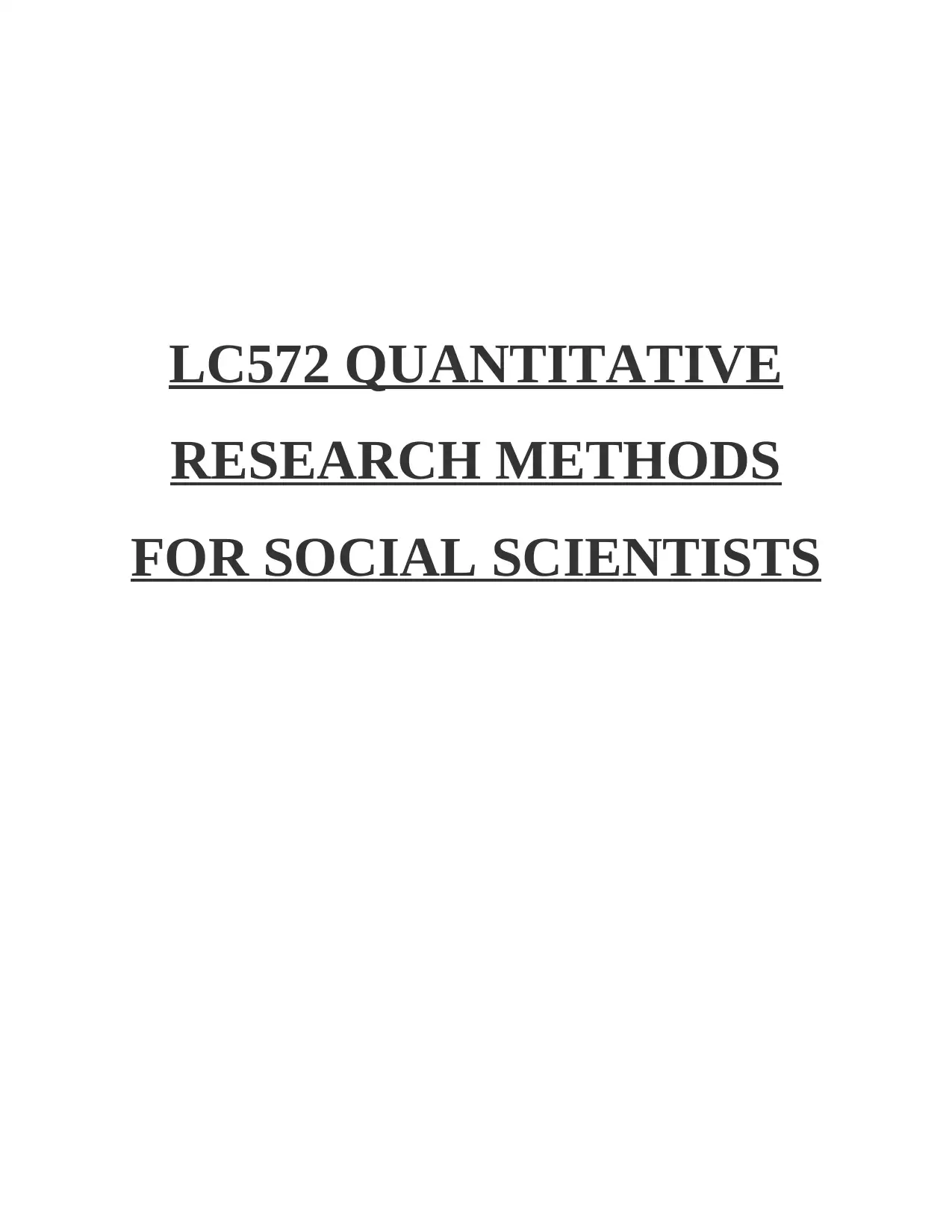
LC572 QUANTITATIVE
RESEARCH METHODS
FOR SOCIAL SCIENTISTS
RESEARCH METHODS
FOR SOCIAL SCIENTISTS
Paraphrase This Document
Need a fresh take? Get an instant paraphrase of this document with our AI Paraphraser
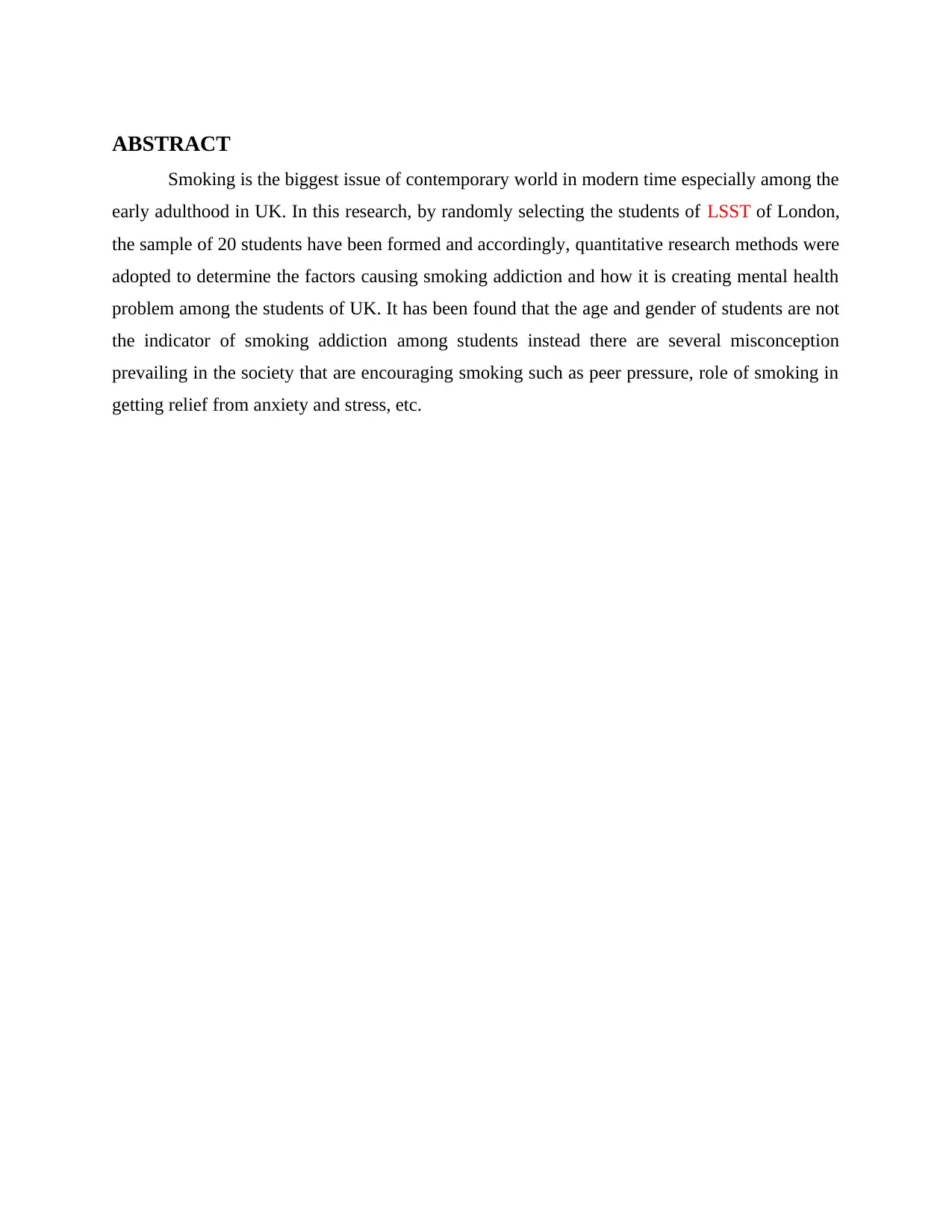
ABSTRACT
Smoking is the biggest issue of contemporary world in modern time especially among the
early adulthood in UK. In this research, by randomly selecting the students of LSST of London,
the sample of 20 students have been formed and accordingly, quantitative research methods were
adopted to determine the factors causing smoking addiction and how it is creating mental health
problem among the students of UK. It has been found that the age and gender of students are not
the indicator of smoking addiction among students instead there are several misconception
prevailing in the society that are encouraging smoking such as peer pressure, role of smoking in
getting relief from anxiety and stress, etc.
Smoking is the biggest issue of contemporary world in modern time especially among the
early adulthood in UK. In this research, by randomly selecting the students of LSST of London,
the sample of 20 students have been formed and accordingly, quantitative research methods were
adopted to determine the factors causing smoking addiction and how it is creating mental health
problem among the students of UK. It has been found that the age and gender of students are not
the indicator of smoking addiction among students instead there are several misconception
prevailing in the society that are encouraging smoking such as peer pressure, role of smoking in
getting relief from anxiety and stress, etc.
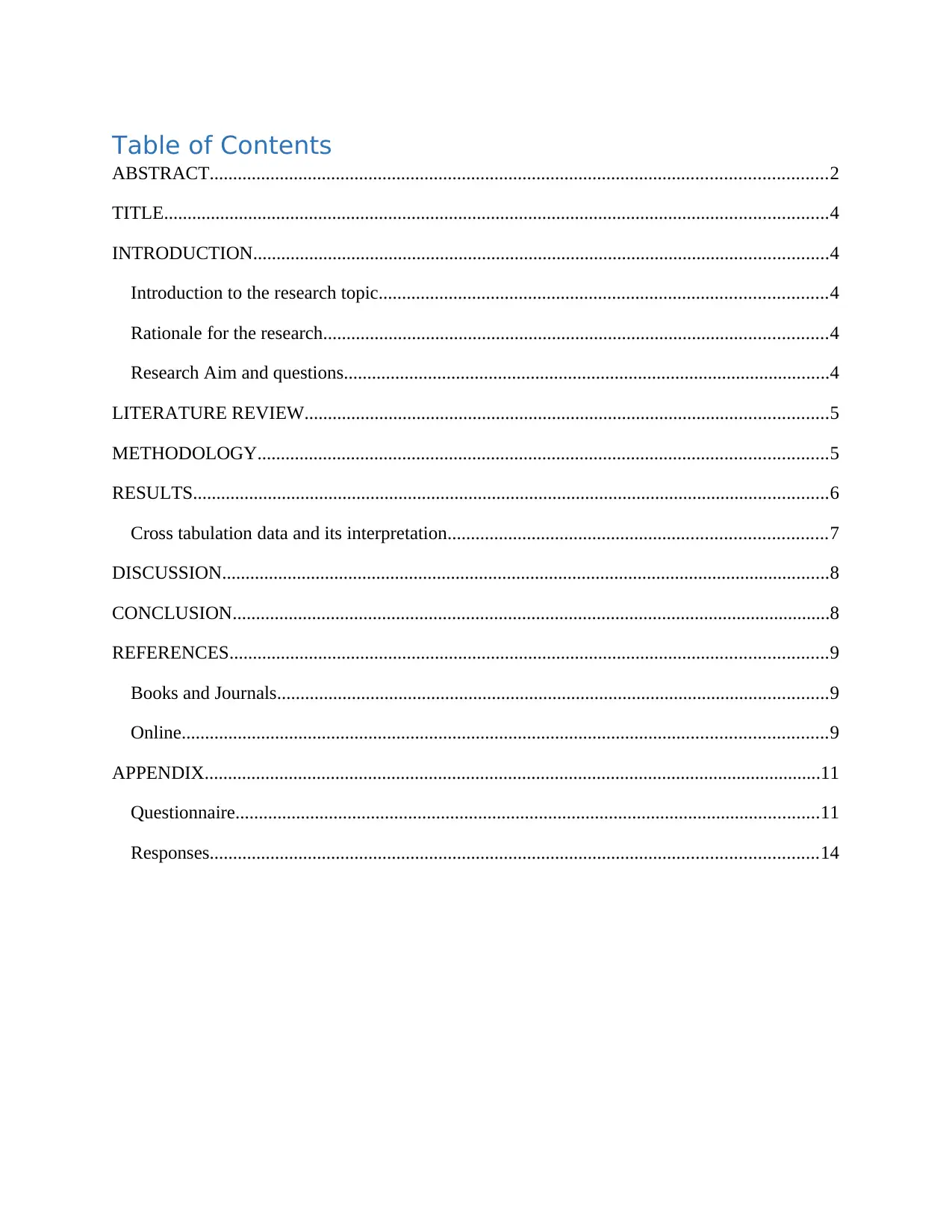
Table of Contents
ABSTRACT....................................................................................................................................2
TITLE..............................................................................................................................................4
INTRODUCTION...........................................................................................................................4
Introduction to the research topic................................................................................................4
Rationale for the research............................................................................................................4
Research Aim and questions........................................................................................................4
LITERATURE REVIEW................................................................................................................5
METHODOLOGY..........................................................................................................................5
RESULTS........................................................................................................................................6
Cross tabulation data and its interpretation.................................................................................7
DISCUSSION..................................................................................................................................8
CONCLUSION................................................................................................................................8
REFERENCES................................................................................................................................9
Books and Journals......................................................................................................................9
Online..........................................................................................................................................9
APPENDIX....................................................................................................................................11
Questionnaire.............................................................................................................................11
Responses..................................................................................................................................14
ABSTRACT....................................................................................................................................2
TITLE..............................................................................................................................................4
INTRODUCTION...........................................................................................................................4
Introduction to the research topic................................................................................................4
Rationale for the research............................................................................................................4
Research Aim and questions........................................................................................................4
LITERATURE REVIEW................................................................................................................5
METHODOLOGY..........................................................................................................................5
RESULTS........................................................................................................................................6
Cross tabulation data and its interpretation.................................................................................7
DISCUSSION..................................................................................................................................8
CONCLUSION................................................................................................................................8
REFERENCES................................................................................................................................9
Books and Journals......................................................................................................................9
Online..........................................................................................................................................9
APPENDIX....................................................................................................................................11
Questionnaire.............................................................................................................................11
Responses..................................................................................................................................14
⊘ This is a preview!⊘
Do you want full access?
Subscribe today to unlock all pages.

Trusted by 1+ million students worldwide
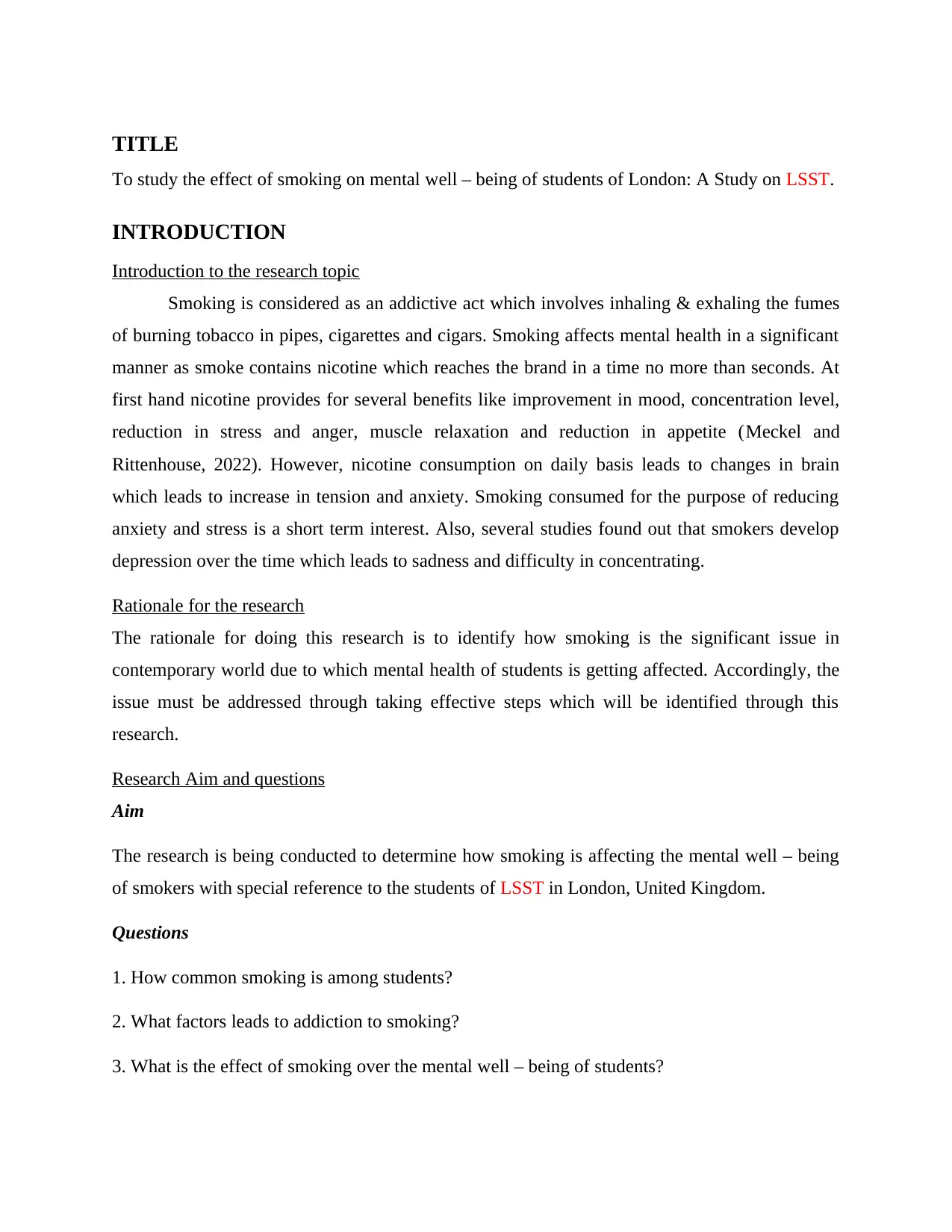
TITLE
To study the effect of smoking on mental well – being of students of London: A Study on LSST.
INTRODUCTION
Introduction to the research topic
Smoking is considered as an addictive act which involves inhaling & exhaling the fumes
of burning tobacco in pipes, cigarettes and cigars. Smoking affects mental health in a significant
manner as smoke contains nicotine which reaches the brand in a time no more than seconds. At
first hand nicotine provides for several benefits like improvement in mood, concentration level,
reduction in stress and anger, muscle relaxation and reduction in appetite (Meckel and
Rittenhouse, 2022). However, nicotine consumption on daily basis leads to changes in brain
which leads to increase in tension and anxiety. Smoking consumed for the purpose of reducing
anxiety and stress is a short term interest. Also, several studies found out that smokers develop
depression over the time which leads to sadness and difficulty in concentrating.
Rationale for the research
The rationale for doing this research is to identify how smoking is the significant issue in
contemporary world due to which mental health of students is getting affected. Accordingly, the
issue must be addressed through taking effective steps which will be identified through this
research.
Research Aim and questions
Aim
The research is being conducted to determine how smoking is affecting the mental well – being
of smokers with special reference to the students of LSST in London, United Kingdom.
Questions
1. How common smoking is among students?
2. What factors leads to addiction to smoking?
3. What is the effect of smoking over the mental well – being of students?
To study the effect of smoking on mental well – being of students of London: A Study on LSST.
INTRODUCTION
Introduction to the research topic
Smoking is considered as an addictive act which involves inhaling & exhaling the fumes
of burning tobacco in pipes, cigarettes and cigars. Smoking affects mental health in a significant
manner as smoke contains nicotine which reaches the brand in a time no more than seconds. At
first hand nicotine provides for several benefits like improvement in mood, concentration level,
reduction in stress and anger, muscle relaxation and reduction in appetite (Meckel and
Rittenhouse, 2022). However, nicotine consumption on daily basis leads to changes in brain
which leads to increase in tension and anxiety. Smoking consumed for the purpose of reducing
anxiety and stress is a short term interest. Also, several studies found out that smokers develop
depression over the time which leads to sadness and difficulty in concentrating.
Rationale for the research
The rationale for doing this research is to identify how smoking is the significant issue in
contemporary world due to which mental health of students is getting affected. Accordingly, the
issue must be addressed through taking effective steps which will be identified through this
research.
Research Aim and questions
Aim
The research is being conducted to determine how smoking is affecting the mental well – being
of smokers with special reference to the students of LSST in London, United Kingdom.
Questions
1. How common smoking is among students?
2. What factors leads to addiction to smoking?
3. What is the effect of smoking over the mental well – being of students?
Paraphrase This Document
Need a fresh take? Get an instant paraphrase of this document with our AI Paraphraser
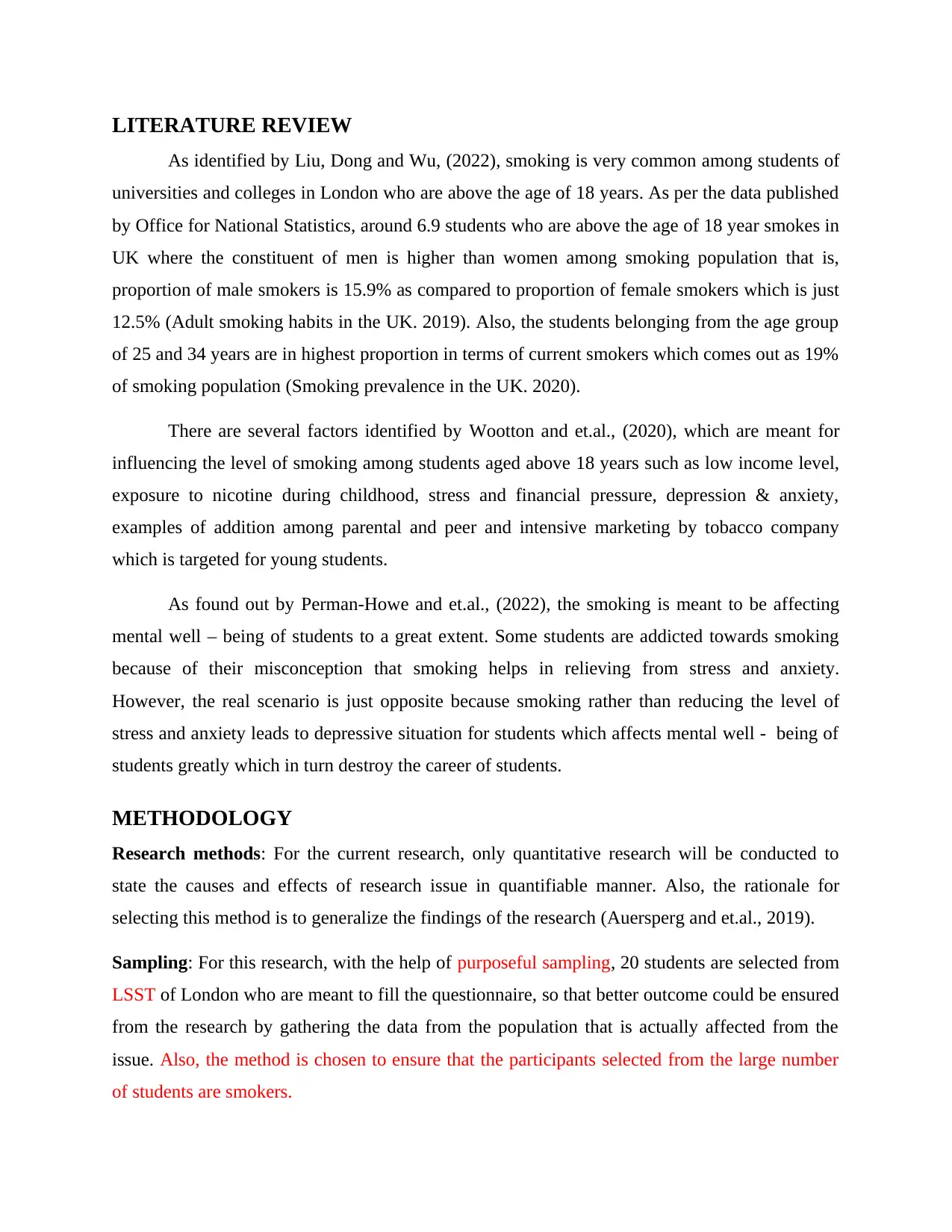
LITERATURE REVIEW
As identified by Liu, Dong and Wu, (2022), smoking is very common among students of
universities and colleges in London who are above the age of 18 years. As per the data published
by Office for National Statistics, around 6.9 students who are above the age of 18 year smokes in
UK where the constituent of men is higher than women among smoking population that is,
proportion of male smokers is 15.9% as compared to proportion of female smokers which is just
12.5% (Adult smoking habits in the UK. 2019). Also, the students belonging from the age group
of 25 and 34 years are in highest proportion in terms of current smokers which comes out as 19%
of smoking population (Smoking prevalence in the UK. 2020).
There are several factors identified by Wootton and et.al., (2020), which are meant for
influencing the level of smoking among students aged above 18 years such as low income level,
exposure to nicotine during childhood, stress and financial pressure, depression & anxiety,
examples of addition among parental and peer and intensive marketing by tobacco company
which is targeted for young students.
As found out by Perman-Howe and et.al., (2022), the smoking is meant to be affecting
mental well – being of students to a great extent. Some students are addicted towards smoking
because of their misconception that smoking helps in relieving from stress and anxiety.
However, the real scenario is just opposite because smoking rather than reducing the level of
stress and anxiety leads to depressive situation for students which affects mental well - being of
students greatly which in turn destroy the career of students.
METHODOLOGY
Research methods: For the current research, only quantitative research will be conducted to
state the causes and effects of research issue in quantifiable manner. Also, the rationale for
selecting this method is to generalize the findings of the research (Auersperg and et.al., 2019).
Sampling: For this research, with the help of purposeful sampling, 20 students are selected from
LSST of London who are meant to fill the questionnaire, so that better outcome could be ensured
from the research by gathering the data from the population that is actually affected from the
issue. Also, the method is chosen to ensure that the participants selected from the large number
of students are smokers.
As identified by Liu, Dong and Wu, (2022), smoking is very common among students of
universities and colleges in London who are above the age of 18 years. As per the data published
by Office for National Statistics, around 6.9 students who are above the age of 18 year smokes in
UK where the constituent of men is higher than women among smoking population that is,
proportion of male smokers is 15.9% as compared to proportion of female smokers which is just
12.5% (Adult smoking habits in the UK. 2019). Also, the students belonging from the age group
of 25 and 34 years are in highest proportion in terms of current smokers which comes out as 19%
of smoking population (Smoking prevalence in the UK. 2020).
There are several factors identified by Wootton and et.al., (2020), which are meant for
influencing the level of smoking among students aged above 18 years such as low income level,
exposure to nicotine during childhood, stress and financial pressure, depression & anxiety,
examples of addition among parental and peer and intensive marketing by tobacco company
which is targeted for young students.
As found out by Perman-Howe and et.al., (2022), the smoking is meant to be affecting
mental well – being of students to a great extent. Some students are addicted towards smoking
because of their misconception that smoking helps in relieving from stress and anxiety.
However, the real scenario is just opposite because smoking rather than reducing the level of
stress and anxiety leads to depressive situation for students which affects mental well - being of
students greatly which in turn destroy the career of students.
METHODOLOGY
Research methods: For the current research, only quantitative research will be conducted to
state the causes and effects of research issue in quantifiable manner. Also, the rationale for
selecting this method is to generalize the findings of the research (Auersperg and et.al., 2019).
Sampling: For this research, with the help of purposeful sampling, 20 students are selected from
LSST of London who are meant to fill the questionnaire, so that better outcome could be ensured
from the research by gathering the data from the population that is actually affected from the
issue. Also, the method is chosen to ensure that the participants selected from the large number
of students are smokers.
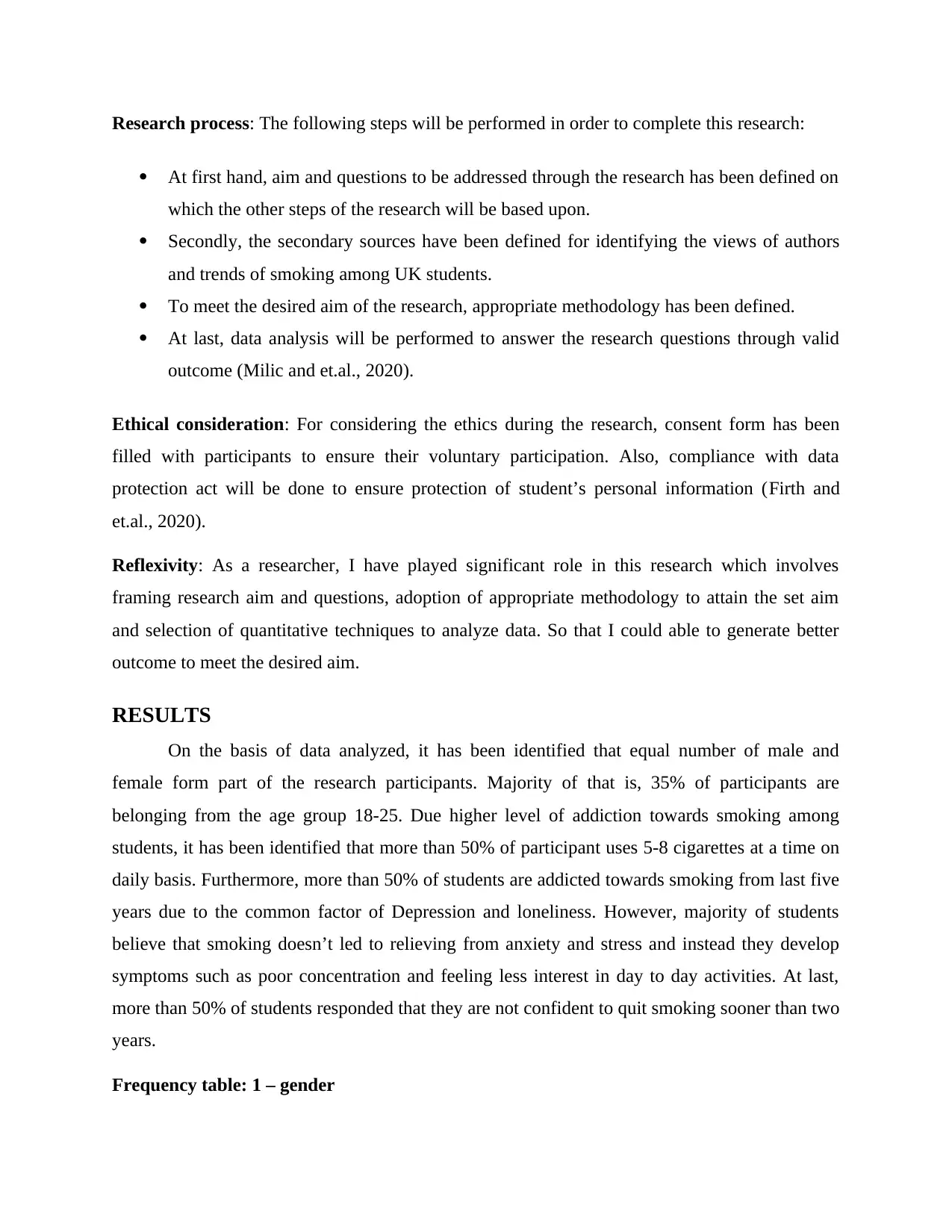
Research process: The following steps will be performed in order to complete this research:
At first hand, aim and questions to be addressed through the research has been defined on
which the other steps of the research will be based upon.
Secondly, the secondary sources have been defined for identifying the views of authors
and trends of smoking among UK students.
To meet the desired aim of the research, appropriate methodology has been defined.
At last, data analysis will be performed to answer the research questions through valid
outcome (Milic and et.al., 2020).
Ethical consideration: For considering the ethics during the research, consent form has been
filled with participants to ensure their voluntary participation. Also, compliance with data
protection act will be done to ensure protection of student’s personal information (Firth and
et.al., 2020).
Reflexivity: As a researcher, I have played significant role in this research which involves
framing research aim and questions, adoption of appropriate methodology to attain the set aim
and selection of quantitative techniques to analyze data. So that I could able to generate better
outcome to meet the desired aim.
RESULTS
On the basis of data analyzed, it has been identified that equal number of male and
female form part of the research participants. Majority of that is, 35% of participants are
belonging from the age group 18-25. Due higher level of addiction towards smoking among
students, it has been identified that more than 50% of participant uses 5-8 cigarettes at a time on
daily basis. Furthermore, more than 50% of students are addicted towards smoking from last five
years due to the common factor of Depression and loneliness. However, majority of students
believe that smoking doesn’t led to relieving from anxiety and stress and instead they develop
symptoms such as poor concentration and feeling less interest in day to day activities. At last,
more than 50% of students responded that they are not confident to quit smoking sooner than two
years.
Frequency table: 1 – gender
At first hand, aim and questions to be addressed through the research has been defined on
which the other steps of the research will be based upon.
Secondly, the secondary sources have been defined for identifying the views of authors
and trends of smoking among UK students.
To meet the desired aim of the research, appropriate methodology has been defined.
At last, data analysis will be performed to answer the research questions through valid
outcome (Milic and et.al., 2020).
Ethical consideration: For considering the ethics during the research, consent form has been
filled with participants to ensure their voluntary participation. Also, compliance with data
protection act will be done to ensure protection of student’s personal information (Firth and
et.al., 2020).
Reflexivity: As a researcher, I have played significant role in this research which involves
framing research aim and questions, adoption of appropriate methodology to attain the set aim
and selection of quantitative techniques to analyze data. So that I could able to generate better
outcome to meet the desired aim.
RESULTS
On the basis of data analyzed, it has been identified that equal number of male and
female form part of the research participants. Majority of that is, 35% of participants are
belonging from the age group 18-25. Due higher level of addiction towards smoking among
students, it has been identified that more than 50% of participant uses 5-8 cigarettes at a time on
daily basis. Furthermore, more than 50% of students are addicted towards smoking from last five
years due to the common factor of Depression and loneliness. However, majority of students
believe that smoking doesn’t led to relieving from anxiety and stress and instead they develop
symptoms such as poor concentration and feeling less interest in day to day activities. At last,
more than 50% of students responded that they are not confident to quit smoking sooner than two
years.
Frequency table: 1 – gender
⊘ This is a preview!⊘
Do you want full access?
Subscribe today to unlock all pages.

Trusted by 1+ million students worldwide
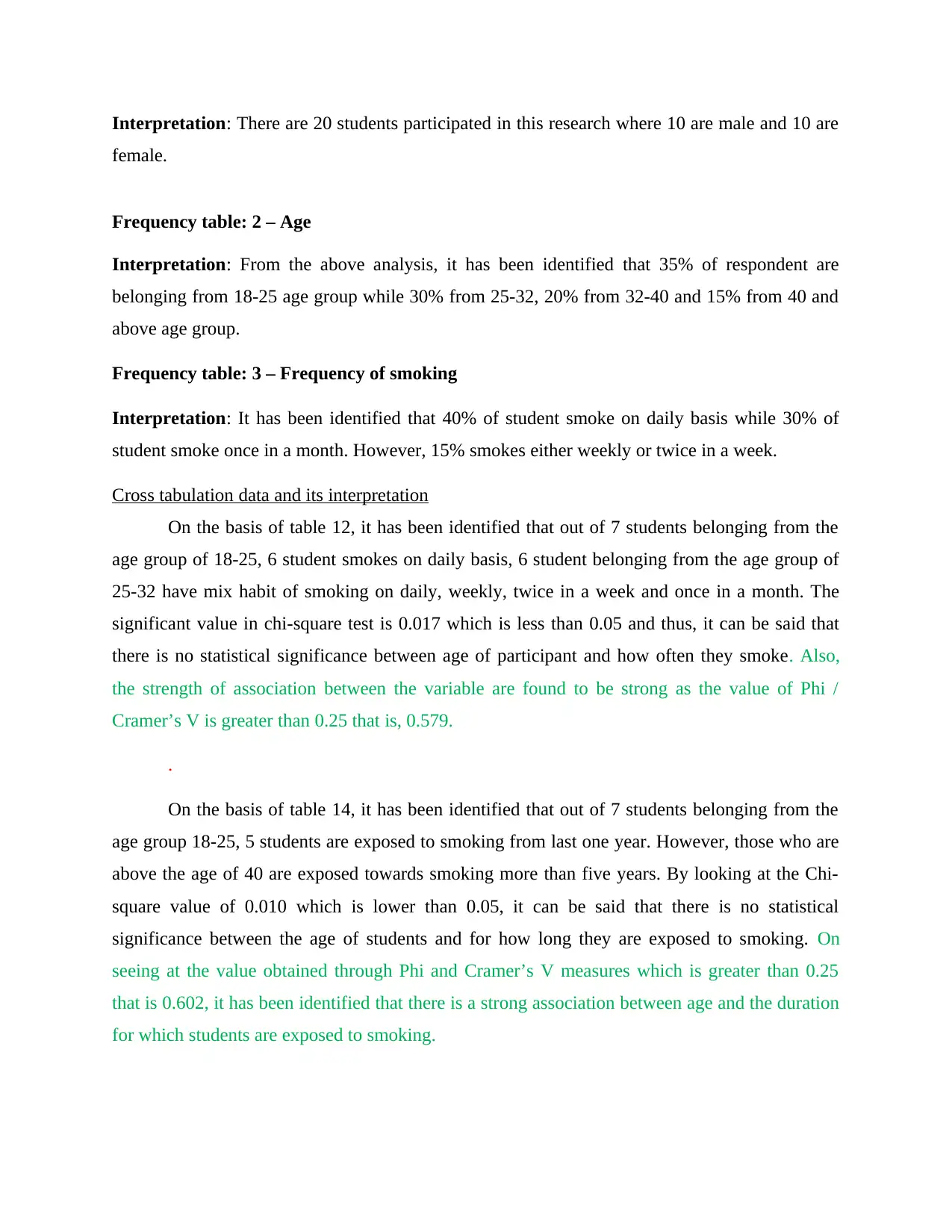
Interpretation: There are 20 students participated in this research where 10 are male and 10 are
female.
Frequency table: 2 – Age
Interpretation: From the above analysis, it has been identified that 35% of respondent are
belonging from 18-25 age group while 30% from 25-32, 20% from 32-40 and 15% from 40 and
above age group.
Frequency table: 3 – Frequency of smoking
Interpretation: It has been identified that 40% of student smoke on daily basis while 30% of
student smoke once in a month. However, 15% smokes either weekly or twice in a week.
Cross tabulation data and its interpretation
On the basis of table 12, it has been identified that out of 7 students belonging from the
age group of 18-25, 6 student smokes on daily basis, 6 student belonging from the age group of
25-32 have mix habit of smoking on daily, weekly, twice in a week and once in a month. The
significant value in chi-square test is 0.017 which is less than 0.05 and thus, it can be said that
there is no statistical significance between age of participant and how often they smoke. Also,
the strength of association between the variable are found to be strong as the value of Phi /
Cramer’s V is greater than 0.25 that is, 0.579.
.
On the basis of table 14, it has been identified that out of 7 students belonging from the
age group 18-25, 5 students are exposed to smoking from last one year. However, those who are
above the age of 40 are exposed towards smoking more than five years. By looking at the Chi-
square value of 0.010 which is lower than 0.05, it can be said that there is no statistical
significance between the age of students and for how long they are exposed to smoking. On
seeing at the value obtained through Phi and Cramer’s V measures which is greater than 0.25
that is 0.602, it has been identified that there is a strong association between age and the duration
for which students are exposed to smoking.
female.
Frequency table: 2 – Age
Interpretation: From the above analysis, it has been identified that 35% of respondent are
belonging from 18-25 age group while 30% from 25-32, 20% from 32-40 and 15% from 40 and
above age group.
Frequency table: 3 – Frequency of smoking
Interpretation: It has been identified that 40% of student smoke on daily basis while 30% of
student smoke once in a month. However, 15% smokes either weekly or twice in a week.
Cross tabulation data and its interpretation
On the basis of table 12, it has been identified that out of 7 students belonging from the
age group of 18-25, 6 student smokes on daily basis, 6 student belonging from the age group of
25-32 have mix habit of smoking on daily, weekly, twice in a week and once in a month. The
significant value in chi-square test is 0.017 which is less than 0.05 and thus, it can be said that
there is no statistical significance between age of participant and how often they smoke. Also,
the strength of association between the variable are found to be strong as the value of Phi /
Cramer’s V is greater than 0.25 that is, 0.579.
.
On the basis of table 14, it has been identified that out of 7 students belonging from the
age group 18-25, 5 students are exposed to smoking from last one year. However, those who are
above the age of 40 are exposed towards smoking more than five years. By looking at the Chi-
square value of 0.010 which is lower than 0.05, it can be said that there is no statistical
significance between the age of students and for how long they are exposed to smoking. On
seeing at the value obtained through Phi and Cramer’s V measures which is greater than 0.25
that is 0.602, it has been identified that there is a strong association between age and the duration
for which students are exposed to smoking.
Paraphrase This Document
Need a fresh take? Get an instant paraphrase of this document with our AI Paraphraser
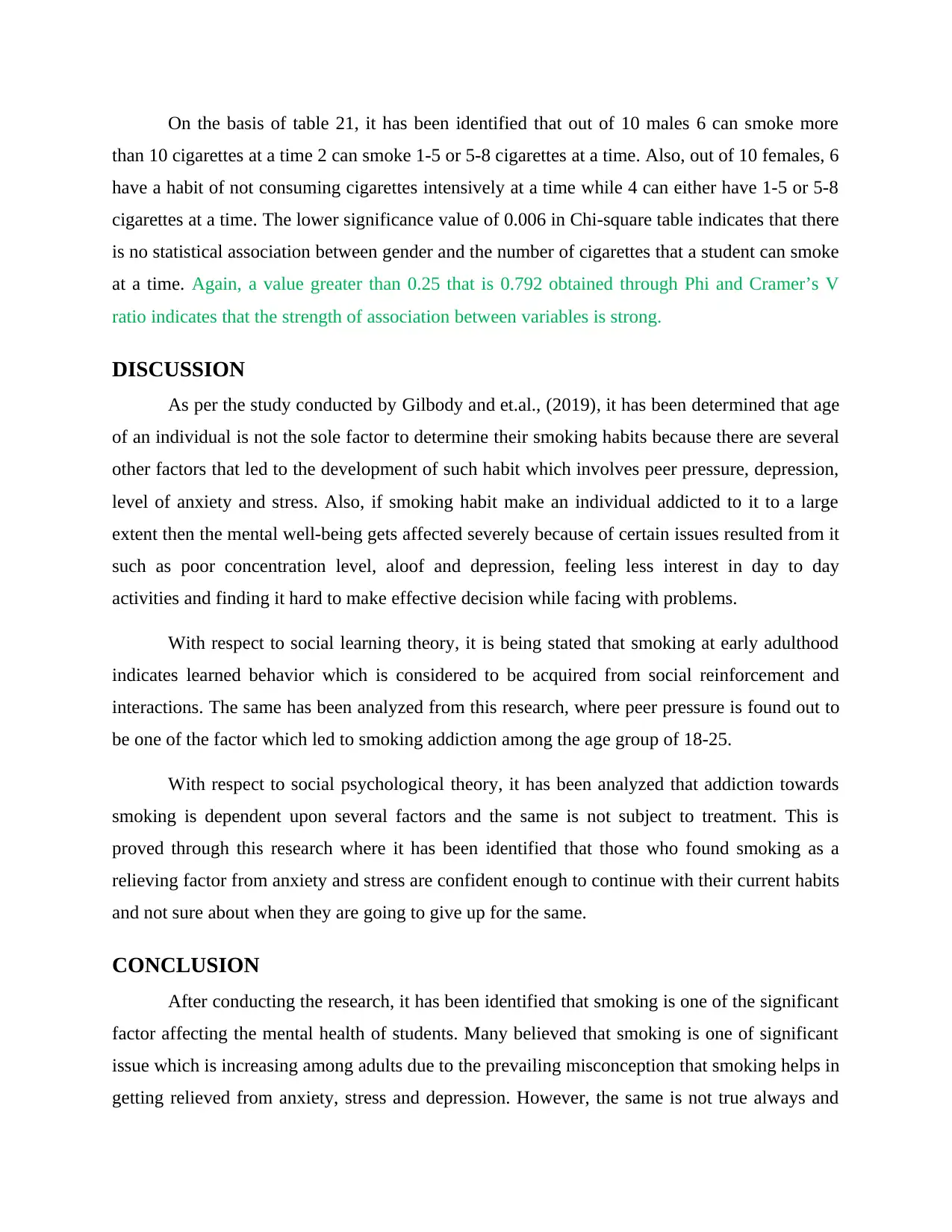
On the basis of table 21, it has been identified that out of 10 males 6 can smoke more
than 10 cigarettes at a time 2 can smoke 1-5 or 5-8 cigarettes at a time. Also, out of 10 females, 6
have a habit of not consuming cigarettes intensively at a time while 4 can either have 1-5 or 5-8
cigarettes at a time. The lower significance value of 0.006 in Chi-square table indicates that there
is no statistical association between gender and the number of cigarettes that a student can smoke
at a time. Again, a value greater than 0.25 that is 0.792 obtained through Phi and Cramer’s V
ratio indicates that the strength of association between variables is strong.
DISCUSSION
As per the study conducted by Gilbody and et.al., (2019), it has been determined that age
of an individual is not the sole factor to determine their smoking habits because there are several
other factors that led to the development of such habit which involves peer pressure, depression,
level of anxiety and stress. Also, if smoking habit make an individual addicted to it to a large
extent then the mental well-being gets affected severely because of certain issues resulted from it
such as poor concentration level, aloof and depression, feeling less interest in day to day
activities and finding it hard to make effective decision while facing with problems.
With respect to social learning theory, it is being stated that smoking at early adulthood
indicates learned behavior which is considered to be acquired from social reinforcement and
interactions. The same has been analyzed from this research, where peer pressure is found out to
be one of the factor which led to smoking addiction among the age group of 18-25.
With respect to social psychological theory, it has been analyzed that addiction towards
smoking is dependent upon several factors and the same is not subject to treatment. This is
proved through this research where it has been identified that those who found smoking as a
relieving factor from anxiety and stress are confident enough to continue with their current habits
and not sure about when they are going to give up for the same.
CONCLUSION
After conducting the research, it has been identified that smoking is one of the significant
factor affecting the mental health of students. Many believed that smoking is one of significant
issue which is increasing among adults due to the prevailing misconception that smoking helps in
getting relieved from anxiety, stress and depression. However, the same is not true always and
than 10 cigarettes at a time 2 can smoke 1-5 or 5-8 cigarettes at a time. Also, out of 10 females, 6
have a habit of not consuming cigarettes intensively at a time while 4 can either have 1-5 or 5-8
cigarettes at a time. The lower significance value of 0.006 in Chi-square table indicates that there
is no statistical association between gender and the number of cigarettes that a student can smoke
at a time. Again, a value greater than 0.25 that is 0.792 obtained through Phi and Cramer’s V
ratio indicates that the strength of association between variables is strong.
DISCUSSION
As per the study conducted by Gilbody and et.al., (2019), it has been determined that age
of an individual is not the sole factor to determine their smoking habits because there are several
other factors that led to the development of such habit which involves peer pressure, depression,
level of anxiety and stress. Also, if smoking habit make an individual addicted to it to a large
extent then the mental well-being gets affected severely because of certain issues resulted from it
such as poor concentration level, aloof and depression, feeling less interest in day to day
activities and finding it hard to make effective decision while facing with problems.
With respect to social learning theory, it is being stated that smoking at early adulthood
indicates learned behavior which is considered to be acquired from social reinforcement and
interactions. The same has been analyzed from this research, where peer pressure is found out to
be one of the factor which led to smoking addiction among the age group of 18-25.
With respect to social psychological theory, it has been analyzed that addiction towards
smoking is dependent upon several factors and the same is not subject to treatment. This is
proved through this research where it has been identified that those who found smoking as a
relieving factor from anxiety and stress are confident enough to continue with their current habits
and not sure about when they are going to give up for the same.
CONCLUSION
After conducting the research, it has been identified that smoking is one of the significant
factor affecting the mental health of students. Many believed that smoking is one of significant
issue which is increasing among adults due to the prevailing misconception that smoking helps in
getting relieved from anxiety, stress and depression. However, the same is not true always and
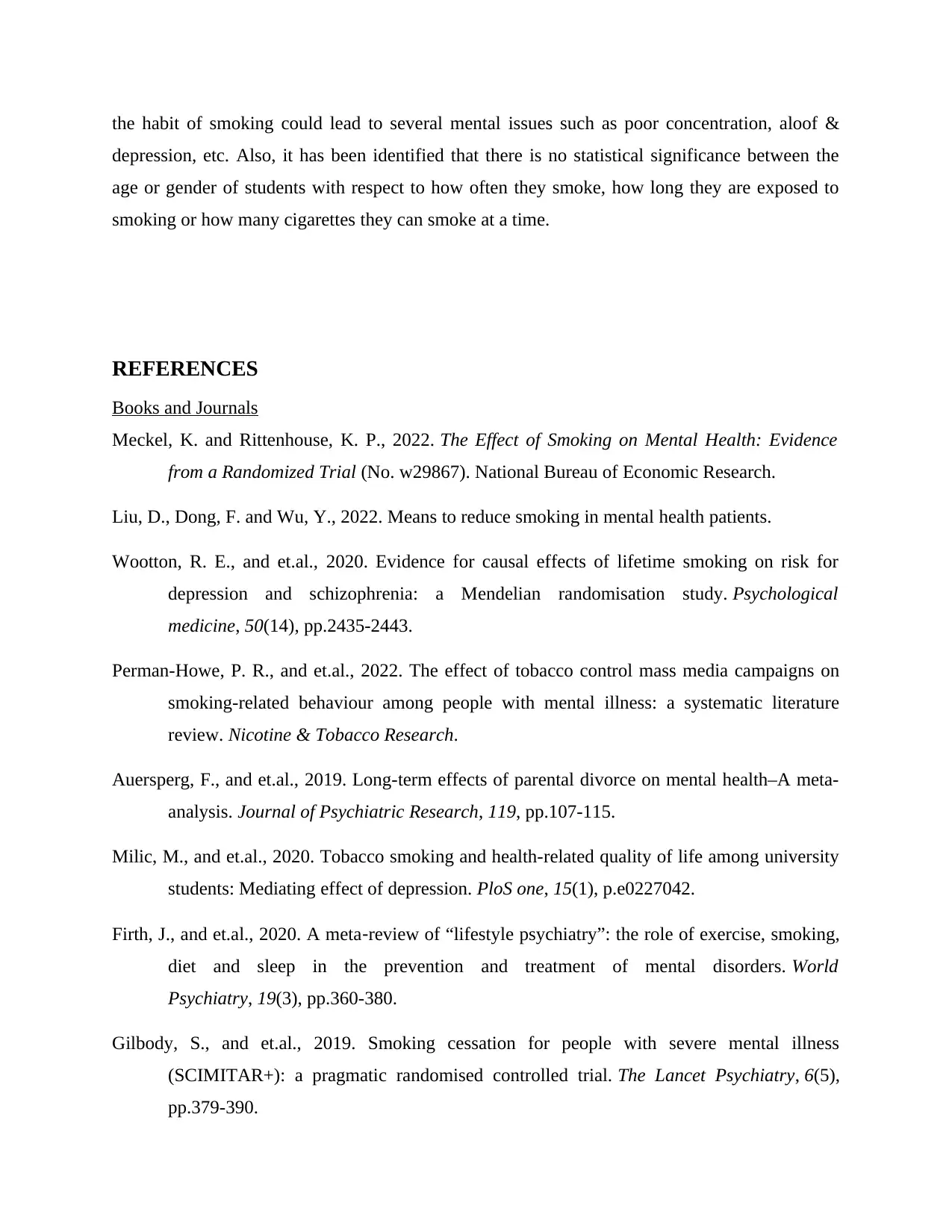
the habit of smoking could lead to several mental issues such as poor concentration, aloof &
depression, etc. Also, it has been identified that there is no statistical significance between the
age or gender of students with respect to how often they smoke, how long they are exposed to
smoking or how many cigarettes they can smoke at a time.
REFERENCES
Books and Journals
Meckel, K. and Rittenhouse, K. P., 2022. The Effect of Smoking on Mental Health: Evidence
from a Randomized Trial (No. w29867). National Bureau of Economic Research.
Liu, D., Dong, F. and Wu, Y., 2022. Means to reduce smoking in mental health patients.
Wootton, R. E., and et.al., 2020. Evidence for causal effects of lifetime smoking on risk for
depression and schizophrenia: a Mendelian randomisation study. Psychological
medicine, 50(14), pp.2435-2443.
Perman-Howe, P. R., and et.al., 2022. The effect of tobacco control mass media campaigns on
smoking-related behaviour among people with mental illness: a systematic literature
review. Nicotine & Tobacco Research.
Auersperg, F., and et.al., 2019. Long-term effects of parental divorce on mental health–A meta-
analysis. Journal of Psychiatric Research, 119, pp.107-115.
Milic, M., and et.al., 2020. Tobacco smoking and health-related quality of life among university
students: Mediating effect of depression. PloS one, 15(1), p.e0227042.
Firth, J., and et.al., 2020. A meta‐review of “lifestyle psychiatry”: the role of exercise, smoking,
diet and sleep in the prevention and treatment of mental disorders. World
Psychiatry, 19(3), pp.360-380.
Gilbody, S., and et.al., 2019. Smoking cessation for people with severe mental illness
(SCIMITAR+): a pragmatic randomised controlled trial. The Lancet Psychiatry, 6(5),
pp.379-390.
depression, etc. Also, it has been identified that there is no statistical significance between the
age or gender of students with respect to how often they smoke, how long they are exposed to
smoking or how many cigarettes they can smoke at a time.
REFERENCES
Books and Journals
Meckel, K. and Rittenhouse, K. P., 2022. The Effect of Smoking on Mental Health: Evidence
from a Randomized Trial (No. w29867). National Bureau of Economic Research.
Liu, D., Dong, F. and Wu, Y., 2022. Means to reduce smoking in mental health patients.
Wootton, R. E., and et.al., 2020. Evidence for causal effects of lifetime smoking on risk for
depression and schizophrenia: a Mendelian randomisation study. Psychological
medicine, 50(14), pp.2435-2443.
Perman-Howe, P. R., and et.al., 2022. The effect of tobacco control mass media campaigns on
smoking-related behaviour among people with mental illness: a systematic literature
review. Nicotine & Tobacco Research.
Auersperg, F., and et.al., 2019. Long-term effects of parental divorce on mental health–A meta-
analysis. Journal of Psychiatric Research, 119, pp.107-115.
Milic, M., and et.al., 2020. Tobacco smoking and health-related quality of life among university
students: Mediating effect of depression. PloS one, 15(1), p.e0227042.
Firth, J., and et.al., 2020. A meta‐review of “lifestyle psychiatry”: the role of exercise, smoking,
diet and sleep in the prevention and treatment of mental disorders. World
Psychiatry, 19(3), pp.360-380.
Gilbody, S., and et.al., 2019. Smoking cessation for people with severe mental illness
(SCIMITAR+): a pragmatic randomised controlled trial. The Lancet Psychiatry, 6(5),
pp.379-390.
⊘ This is a preview!⊘
Do you want full access?
Subscribe today to unlock all pages.

Trusted by 1+ million students worldwide

Online
Adult smoking habits in the UK. 2019. [Online]. Available through <
https://www.ons.gov.uk/peoplepopulationandcommunity/healthandsocialcare/
healthandlifeexpectancies/bulletins/adultsmokinghabitsingreatbritain/2019>
Smoking prevalence in the UK. 2020. [Online]. Available through <
https://www.ons.gov.uk/peoplepopulationandcommunity/healthandsocialcare/
drugusealcoholandsmoking/bulletins/
smokingprevalenceintheukandtheimpactofdatacollectionchanges/2020>
Adult smoking habits in the UK. 2019. [Online]. Available through <
https://www.ons.gov.uk/peoplepopulationandcommunity/healthandsocialcare/
healthandlifeexpectancies/bulletins/adultsmokinghabitsingreatbritain/2019>
Smoking prevalence in the UK. 2020. [Online]. Available through <
https://www.ons.gov.uk/peoplepopulationandcommunity/healthandsocialcare/
drugusealcoholandsmoking/bulletins/
smokingprevalenceintheukandtheimpactofdatacollectionchanges/2020>
Paraphrase This Document
Need a fresh take? Get an instant paraphrase of this document with our AI Paraphraser
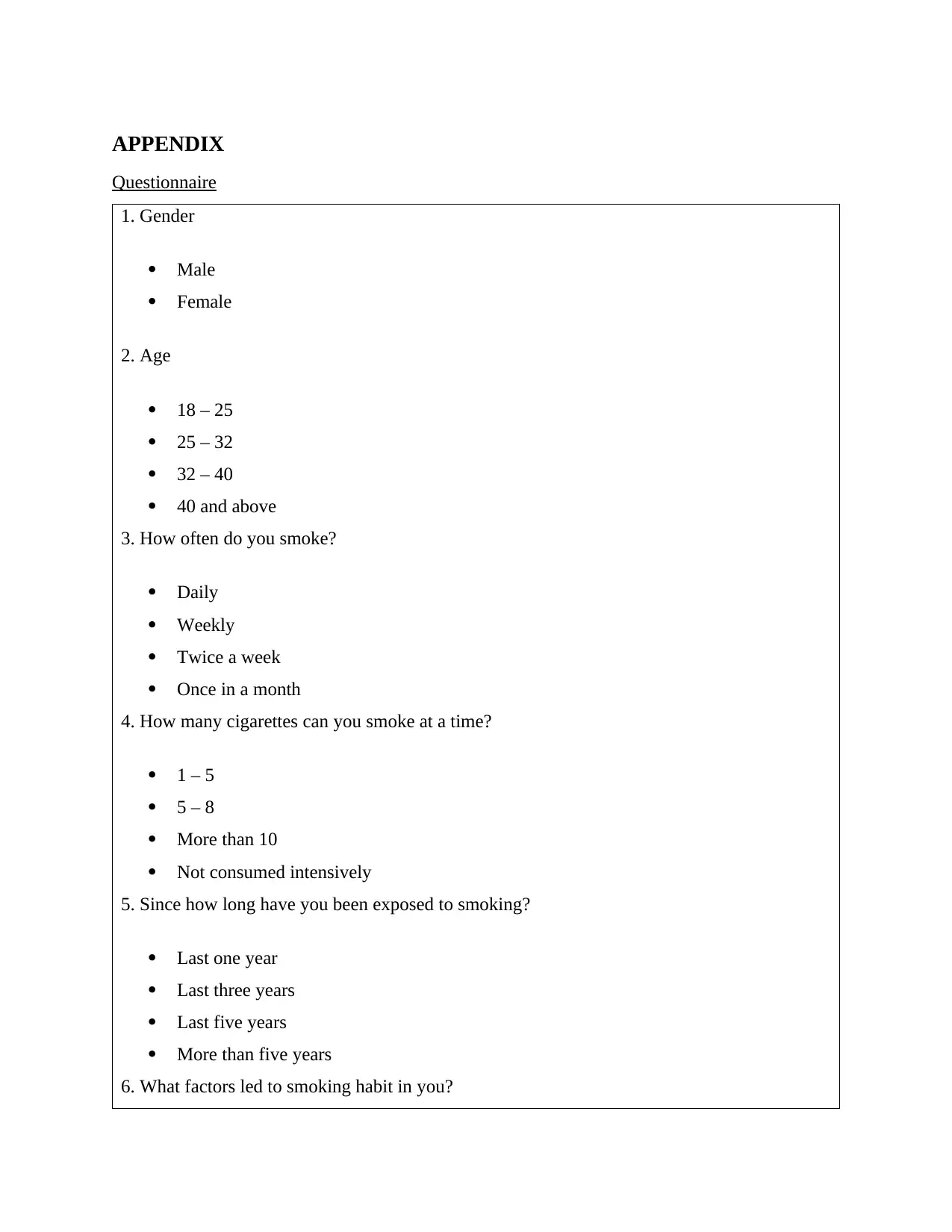
APPENDIX
Questionnaire
1. Gender
Male
Female
2. Age
18 – 25
25 – 32
32 – 40
40 and above
3. How often do you smoke?
Daily
Weekly
Twice a week
Once in a month
4. How many cigarettes can you smoke at a time?
1 – 5
5 – 8
More than 10
Not consumed intensively
5. Since how long have you been exposed to smoking?
Last one year
Last three years
Last five years
More than five years
6. What factors led to smoking habit in you?
Questionnaire
1. Gender
Male
Female
2. Age
18 – 25
25 – 32
32 – 40
40 and above
3. How often do you smoke?
Daily
Weekly
Twice a week
Once in a month
4. How many cigarettes can you smoke at a time?
1 – 5
5 – 8
More than 10
Not consumed intensively
5. Since how long have you been exposed to smoking?
Last one year
Last three years
Last five years
More than five years
6. What factors led to smoking habit in you?
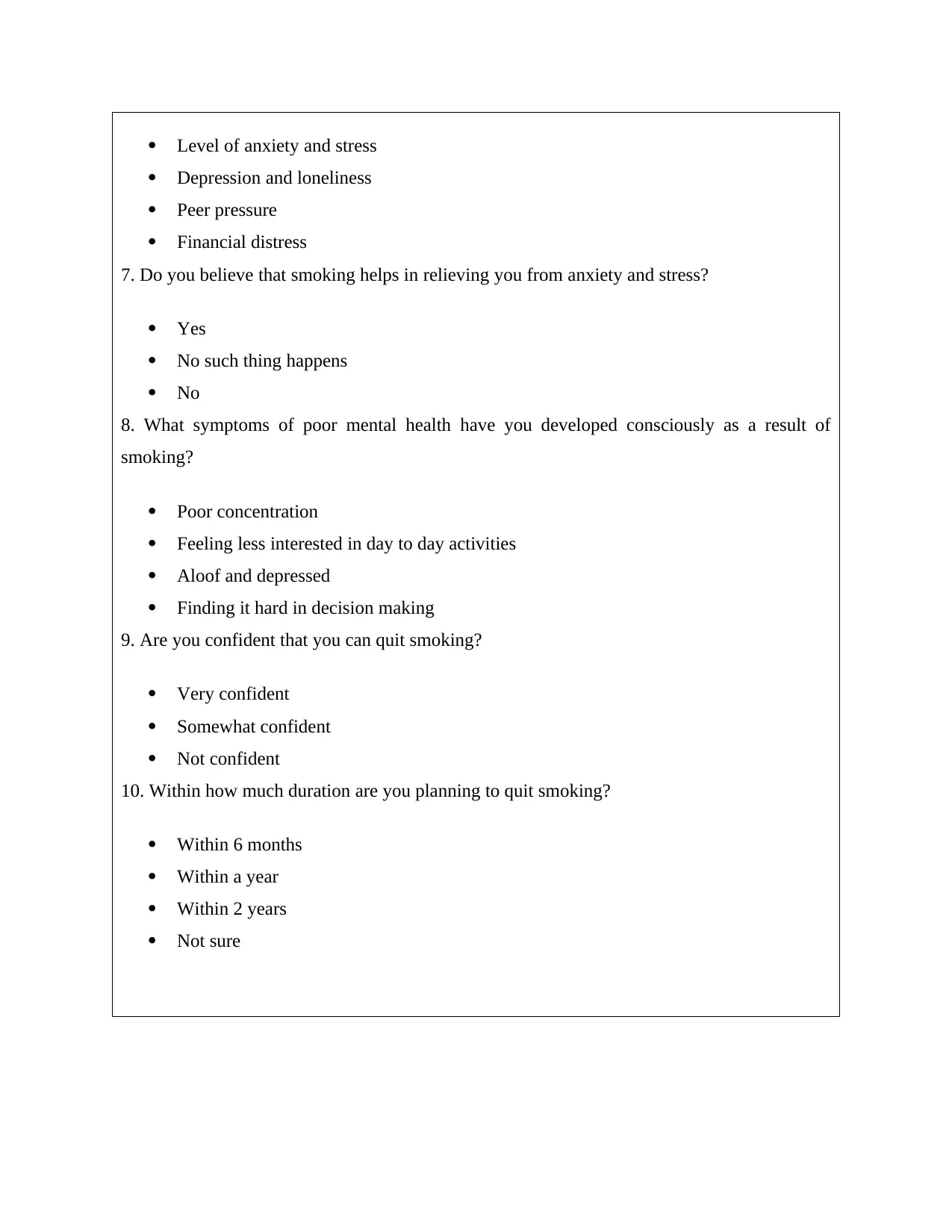
Level of anxiety and stress
Depression and loneliness
Peer pressure
Financial distress
7. Do you believe that smoking helps in relieving you from anxiety and stress?
Yes
No such thing happens
No
8. What symptoms of poor mental health have you developed consciously as a result of
smoking?
Poor concentration
Feeling less interested in day to day activities
Aloof and depressed
Finding it hard in decision making
9. Are you confident that you can quit smoking?
Very confident
Somewhat confident
Not confident
10. Within how much duration are you planning to quit smoking?
Within 6 months
Within a year
Within 2 years
Not sure
Depression and loneliness
Peer pressure
Financial distress
7. Do you believe that smoking helps in relieving you from anxiety and stress?
Yes
No such thing happens
No
8. What symptoms of poor mental health have you developed consciously as a result of
smoking?
Poor concentration
Feeling less interested in day to day activities
Aloof and depressed
Finding it hard in decision making
9. Are you confident that you can quit smoking?
Very confident
Somewhat confident
Not confident
10. Within how much duration are you planning to quit smoking?
Within 6 months
Within a year
Within 2 years
Not sure
⊘ This is a preview!⊘
Do you want full access?
Subscribe today to unlock all pages.

Trusted by 1+ million students worldwide
1 out of 41
Related Documents
Your All-in-One AI-Powered Toolkit for Academic Success.
+13062052269
info@desklib.com
Available 24*7 on WhatsApp / Email
![[object Object]](/_next/static/media/star-bottom.7253800d.svg)
Unlock your academic potential
Copyright © 2020–2025 A2Z Services. All Rights Reserved. Developed and managed by ZUCOL.





